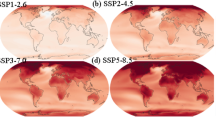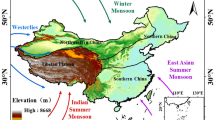Abstract
An analysis of surface air temperature changes over Saudi Arabia is presented using the Climate Wizard Tool. Projections of temperature departures from four global circulation models (GCMs) under three emission scenarios (Special Report on Emissions Scenarios (SRES) A2, A1B, and B1) were used in the analysis. The analysis has been carried out for two future time periods: mid-century (2040–2069) and end-century (2070–2099). Results indicate positive departures throughout Saudi Arabia with the greatest warming generally focussed on the central region. A clear transition to a hotter climate from the mid-century to end-century was evident from the results. Analysis of projected temperature departures at four locations, namely Jeddah, Riyadh, Dammam, and Jazan, revealed that Riyadh is likely to experience the highest warming with projected departures under A2 scenario exceeding 3.5 and 5.5 °C for the mid-century and end-century, respectively. Results of ensemble analysis indicate that, under A2 scenario, 80 % of the models project an increase of 3 °C for the mid-century and 5 °C for the end-century period. About 20 % of the models indicated increases, under the conservative B1 scenario, of 1.67 and 2.24 °C for the mid-century and end-century periods, respectively. Among the four models, the highest and the lowest departures were generally projected by the CGCM3.1 and CSIROMk3.0 models, respectively. Of the three emission scenarios, A2 tends to force greater warming than the other two scenarios. With significant warming projected for mid-century as well as end-century, socioeconomic systems in Saudi Arabia will face tremendous pressure. Urgent measures are required to reduce greenhouse gas emissions in order to mitigate the impacts of enhanced warming. The results presented herein could provide valuable aid to policy makers in formulating adaptation and mitigation strategies to counteract the adverse impacts of climate change in Saudi Arabia.











Similar content being viewed by others
References
Abderrahman WA, Al-Harazin IM (2008) Assessment of climate changes on water resources in the Kingdom of Saudi Arabia, GCC Environment and Sustainable Development Symposium, 28 – 30 January 2008, Dhahran, Saudi Arabia, pp D-1-1 – D-1-13
Al Zawad FM (2008) Impacts of climate change on water resources in Saudi Arabia, The 3rd International Conference on Water Resources and Arid Environments, Riyadh, KSA
Al Zawad FM, Aksakal A (2010) Impacts of climate change on water resources in Saudi Arabia. In: Dincer I, Midilli A, Hepbasli A, Hikmet Karakoc T (eds) Global warming: engineering solutions. Springer, New York
Alam SMS, Sharif M (2013) Assessment of climate change scenario in the Middle-East Region. J Emerg Technol Adv Eng 3(6):367–372
Alkolibi FM (2002) Possible effects of global warming on agriculture and water resources in Saudi Arabia: impacts and responses. Clim Chang 54:225–245
Almazroui M (2012) Temperature variability over Saudi Arabia during the period 1978–2010 and its association with global climate indices. JKAU: Meteorology, Environment, Arid Land Agriculture Science 23(1). doi: 10.4197/Met.23–1.6
Almazroui M, Islam MN, Athar H, Jones PD, Rahman MA (2012a) Recent climate change in the Arabian Peninsula: annual rainfall and temperature analysis of Saudi Arabia for 1978–2009. Int J Climatol 32:953–966. doi:10.1002/joc.3446
Almazroui M, Islam MN, Jones PD, Athar H, Rahman MA (2012b) Recent climate change in the Arabian Peninsula: seasonal rainfall and temperature climatology of Saudi Arabia for 1979–2009. Atmos Res 111:29–45. doi:10.1016/j.atmosres.2012.02.013
Almazroui MM, Nazrul I, Ramzah D, Jones PD (2013) Trends of temperature extremes in Saudi Arabia. Int J Climatol. doi:10.1002/joc.3722
Aquastat (2008) FAO’s Information System on Water and Agriculture. Climate information tool
Araújo MB, New M (2007) Ensemble forecasting of species distributions. Trends Ecol Evol 22:42–47. doi:10.1016/j.tree.2006.09.010
Chowdhury S, Al-Zahrani M (2013) Implications of climate change on water resources in Saudi Arabia. Arab J Sci Eng 38:1959–1971
Chu JT, Xia J, Xu CY, Singh VP (2010) Statistical downscaling of daily mean temperature, pan evaporation and precipitation for climate change scenarios in Haihe River, China. Theor Appl Climatol 99:149–161
Elnesr M, Alazba A, Abu-zreig M (2010) Analysis of Evapotranspiration Variability and Trends in the Arabian Peninsula, American Journal of Environmental Sciences, 6(6), 535–547
FAO (2009) Water and agriculture in Saudi Arabia. AQUASTAT - FAO's Information System on Water and Agriculture. FAO. http://www.fao.org/nr/water/aquastat/countries/saudi_arabia/index.stm
Flato GM, Boer GJ (2001) Warming asymmetry in climate change simulations. Geophysical Research Letters, 28(1), 195–198
Girvetz EH, Zganjar C, Raber GT, Maurer EP, Kareiva P et al (2009) Applied climate-change analysis: The Climate Wizard Tool. PLoS One 4(12):e8320. doi:10.1371/journal.pone.0008320
Gleick P (2006) The world’s water 2006–2007. Pacific Institute for Studies in Development, Environment, and Security, Washington, DC, USA
Gordon HB, Rotstayn LD, McGregor JL, Dix MR, Kowalczyk EA, O’Farrell SP, Waterman LJ, Hirst AC, Wilson SG, Collier MA, Watterson IG, Elliott TI (2002) The CSIRO Mk3 Climate System Model. CSIRO Atmospheric Research Technical Paper No. 60
GULF N (2010) Summer heat causes blowouts in Saudi electric grid [Online]. Available: http://gulfnews.com/news/gulf/saudi-arabia/summer-heat-causes-blowouts-in-saudi-electricgrid-1.644504 [Accessed 12 January 2014]
IPCC (2000) Special report on emissions scenarios. Intergovernmental panel on Climate Change, Cambridge University Press
IPCC (2007) In: Parry ML, Canziani OF, Palutikof JP, van der Linden PJ, Hanson CE (eds) Impacts, Adaptation and Vulnerability, Contribution of Working Group II to the Fourth Assessment Report of the Intergovernmental Panel on Climate Change. Cambridge University Press, Cambridge, UK, p 976
Jones PD, Lister DH, Osborn TJ, Harpham C, Salmon M, Morice CP (2012) Hemispheric and large-scale land surface air temperature variations: an extensive revision and an update to 2010. J Geophys Res. doi:10.1029/2011JD017139
Jungclaus JH, Keenlyside N, Botzet M, Haak H, Luo JJ, Latif M, Marotzke J, Mikolajewicz U, Roeckner E (2006) Ocean Circulation and Tropical Variability in the Coupled Model ECHAM5/MPI-OM. J. Climate, 19, 3952–3972.
Kennedy JJ, Rayner NA, Smith RO, Saunby M, Parker DE (2011) Reassessing biases and other uncertainties in sea-surface temperature observations measured in situ since 1850 part 2: biases and homogenisation. Journal of Geophysical Research 116, doi:10.1029/2010JD015220
Mearns LO, Giorgi F, Wetton P, Pabon D, Hulme M, Lal M (2003) Guidelines for use of climate scenarios developed from regional climate model experiments. IPCC task group on scenarios for climate impact assessment guidance note
Ragab R, Prudhomme C (2000) Climate change and water resources management in the southern Mediterranean and Middle East countries. In The Second World Water Forum 17–22, March 2000, The Hague
Rehman S (2010) Temperature and rainfall variation over Dhahran, Saudi Arabia, (1970–2006). Int J Climatol 30:445–449. doi:10.1002/joc.1907
Reichler T, Kim J (2008) Uncertainties in the climate mean state of global observations, reanalyses, and the GFDL climate model. J Geophys Res-Atmos 113
Sang YF (2012) Spatial and temporal variability of daily temperature in the Yangtze River Delta, China. Atmos Res 112:12–24
Serrat-Capdevila A, Valdes J, Perez J, Baird K, Mata L, Maddock T III (2007) Modeling climate change impacts—and uncertainty—on the hydrology of riparian system: the San Pedro Basin (Arizona/Sonora). J Hydrol 347:48–66
Sharif M, Burn D (2006) Simulating climate change scenarios using an improved K-nearest neighbor model. J Hydrol 325:179–196
SOUHAIL KARAM (REUTERS) (2008) Saudi Arabia scraps wheat growing to save water [Online]. Available: http://www.reuters.com/article/2008/01/08/idUSL08699206 [Accessed 10 January 2014]
UKMO (2011) Climate: observations, projections and impacts., Technical Report, Tyndall Centre, United Kingdom Meteorological Office
WMO (2011) World meteorological organization statement on status of the global climate in 2010, WMO-No. 1074, Available online: http://www.wmo.int/pages/prog/wcp/wcdmp/statement/wmostatement_en.html
Yinlong X, Xiaoying H, Yong Z, Wantao L, Erda L (2006) Stat Anal Clim Chang Scenarios over China in the 21st Century 1719:50–54
Presidency of Meteorology and Environment (2005) First National Communication of the Kingdom of Saudi Arabia, submitted to the UNFCCC. PME, Riyadh, KSA
Author information
Authors and Affiliations
Corresponding author
Rights and permissions
About this article
Cite this article
Sharif, M. Analysis of projected temperature changes over Saudi Arabia in the twenty-first century. Arab J Geosci 8, 8795–8809 (2015). https://doi.org/10.1007/s12517-015-1810-y
Received:
Accepted:
Published:
Issue Date:
DOI: https://doi.org/10.1007/s12517-015-1810-y




